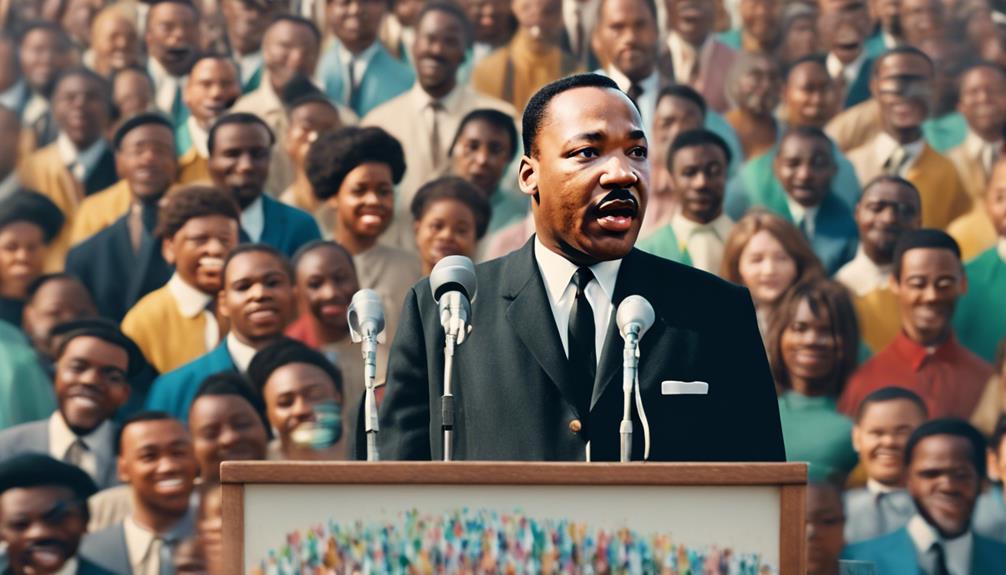MLK effectively employs figurative language such as metaphors, similes, imagery, personification, alliteration, and symbolism in his speeches. The metaphors, like comparing justice to a 'mighty stream,' make complex ideas relatable. Similes create vivid images and emotional connections, inspiring action for equality. Imagery vividly portrays injustices and hope for progress. Personification humanizes abstract concepts, enhancing emotional impact. Symbolism adds layers of meaning, deeply resonating with audiences. These techniques not only convey powerful messages but also inspire change and empathy. There's much to discover about MLK's impactful use of figurative language within his speeches.
Key Takeaways
- Metaphors like 'mighty stream' convey justice.
- Similes create vivid imagery for racial equality.
- Imagery depicts injustices and progress.
- Personification humanizes discrimination for empathy.
- Symbolism enriches messages of equality and justice.
Types of Figurative Language Used
In MLK's speeches, a variety of figurative language techniques such as metaphors, similes, imagery, personification, alliteration, and symbolism are skillfully employed to convey impactful messages and engage the audience. These techniques serve to create vivid images and emotional resonance, allowing listeners to better connect with the profound themes of justice, equality, and freedom. Similarly, the use of figurative language in “The Road Not Taken” by Robert Frost enriches the poem’s meaning, as the diverging roads symbolize life’s choices and the inevitable consequences that come with them. Both Frost and MLK masterfully utilize figurative language to invite deeper reflection on the human experience.
Martin Luther King's use of metaphors and similes creates vivid comparisons that help the audience relate to complex social issues. Imagery, on the other hand, paints a visual picture in the minds of listeners, making the messages more compelling and memorable.
Personification is utilized to humanize abstract concepts, making them more relatable and emotionally resonant. Alliteration in MLK's speeches not only adds a musical quality but also emphasizes key points, leaving a lasting impression on the audience.
Additionally, symbolism is strategically woven into the speeches to underscore important themes and inspire action for social change. Each of these figurative language techniques serves a distinct purpose in enhancing the effectiveness of MLK's messages and galvanizing individuals to work towards a more just and equitable society.
Metaphors in MLK's Speeches

Comparing justice to a 'mighty stream' in his iconic 'I Have a Dream' speech, MLK skillfully utilized metaphors to vividly illustrate profound societal concepts. Through metaphors like 'dark and desolate valley,' MLK symbolized the harsh realities of segregation and oppression that plagued society. These metaphors weren't mere literary devices but powerful tools that enabled MLK to convey complex ideas in a more engaging and emotional manner to his audience.
In his speeches, MLK often used metaphors that connected the challenges of discrimination to the universal pursuit of freedom and equality. By employing vivid imagery and figurative language, he enhanced the impact of his message, inspiring action towards social justice and equality. These metaphors served as beacons of hope and unity, rallying individuals to stand against injustice and work towards a more equitable world. MLK's masterful use of metaphors continues to resonate with audiences, underscoring the enduring power of his words in the fight for a more just society.
Similes and Their Impact

Similes in MLK's speeches serve to create vivid imagery and enhance emotional impact, making complex ideas more relatable for the audience.
By comparing justice to water and righteousness to a mighty stream, MLK emphasizes universal freedom and the urgency for social change.
The use of similes not only evokes powerful emotions but also inspires action towards racial equality and social justice.
Similes for Vivid Imagery
Utilizing vivid similes in MLK's speeches enhances the audience's emotional connection, driving home the urgency of justice and righteousness.
MLK's similes, such as 'Justice rolls down like waters' and 'Righteousness like a mighty stream,' paint powerful images of justice and righteousness flowing abundantly and with great strength. These comparisons to tangible elements help make abstract concepts more relatable, impactful, and memorable for the audience.
Emotional Impact of Similes
MLK's skillful incorporation of similes in his speeches not only enhances the audience's emotional connection but also amplifies the urgency of justice and righteousness.
- Similes evoke strong emotions, intensifying the impact of MLK's words on social justice and equality.
- Through vivid comparisons, similes make complex concepts relatable, fostering empathy and understanding among listeners.
- The emotional resonance of similes in MLK's speeches inspires action, mobilizing individuals towards positive social change.
Similes serve as powerful tools in MLK's rhetoric, effectively conveying the depth of societal challenges and emphasizing key messages with compelling imagery. Their emotional impact not only captivates the audience but also drives them to reflect and act upon the urgent call for justice and equality.
Imagery in MLK's Rhetoric

Imagery vividly portrays the injustices faced by African Americans in MLK's speeches. For instance, he compares segregation to a 'dark and desolate valley,' painting a bleak picture of the harsh realities endured by many.
MLK's use of metaphor is equally striking; he likens justice to water and righteousness to a mighty stream, emphasizing the essential nature of these concepts. Through personification, abstract ideals like freedom are given human attributes, connecting with the audience on a deeply emotional level.
Metaphors, such as the 'sunlit path of racial justice,' symbolize hope and progress towards equality, inspiring listeners to aspire for a better future. Repetition, like the iconic phrase 'Let freedom ring,' underscores the universal significance of the civil rights movement, uniting individuals in a collective quest for justice and equality.
In his speeches, MLK's imagery transcends mere words, evoking powerful emotions and compelling action towards a more just society.
Personification Techniques

In exploring MLK's rhetorical strategies, we uncover how personification techniques deeply resonate with audiences by infusing abstract concepts with human qualities.
- MLK used personification to emotionally connect with abstract concepts like discrimination, poverty, and freedom in his speeches.
- Personification was employed to give human qualities to segregation, discrimination, and other societal issues, making them more relatable.
- By attributing human characteristics to non-human entities, MLK made his messages more engaging and impactful for the audience.
Martin Luther King Jr. skillfully utilized personification to bring to life complex societal issues such as segregation and discrimination. Through this technique, he transformed these abstract concepts into characters that the audience could relate to on a human level. By giving a voice and personality to themes like freedom, equality, and justice, King made his messages more accessible and compelling, resonating deeply with listeners. The use of personification helped create vivid imagery and understanding, enhancing the emotional connection to the core themes of his speeches.
Symbolism in MLK's Messages

Symbolism in MLK's messages plays an essential role in conveying complex emotions and themes. By using symbols like colors and imagery, MLK evokes powerful emotions and connects ideas within his speeches.
Understanding the meaning behind these symbols enriches our appreciation of the depth and impact of MLK's messages.
Symbolic Imagery Analysis
MLK's speeches were enriched with symbolic imagery, vividly capturing the essence of deeper meanings and emotions to resonate profoundly with his audience.
- MLK utilized the sunlit path of justice to symbolize equality and goodness.
- Symbolism in MLK's messages evoked strong emotions and connections with listeners.
- Common symbols like colors and imagery were strategically employed to convey themes of injustice, oppression, and the struggle for civil rights.
Through these powerful symbolic representations, MLK effectively communicated complex ideas, inspiring individuals to work towards social change and equality. The use of symbolism added depth and resonance to his messages, making them more engaging and memorable for all who heard them.
Impact of Symbolic Language
Enriching his speeches with symbolic imagery, MLK captivated audiences by conveying profound meanings and emotions beyond mere words. Through symbols like 'justice as a mighty stream' and 'freedom ringing across the nation,' MLK's speeches carried powerful messages of equality and justice, resonating deeply with listeners.
The impact of symbolic language in MLK's speeches was profound, enhancing the urgency and importance of the civil rights movement. These symbols added layers of meaning and depth to his message, fueling emotional connections and inspiring action towards a more just and equitable society.
MLK's use of symbolism not only made his speeches memorable but also stirred hearts and minds, leaving an indelible mark on the fight for equality and justice.
Meaning Behind Symbols
In exploring the significance of symbols in MLK's speeches, we uncover a profound layer of meaning that resonates deeply with the essence of social justice and equality.
Symbols like the 'sunlit path of racial justice' embody the ideals of equality and goodness.
The representation of 'mountains' symbolizes the enduring struggle for civil rights in MLK's messages.
Through strategic use of symbolism, MLK added depth and emotional connection to his powerful message of social justice and equality.
MLK's deliberate incorporation of common symbols, colors, and imagery served to evoke strong emotions and create a lasting impact on his audience, enhancing the understanding and engagement with his pivotal civil rights speeches.
Frequently Asked Questions
What Is an Example of a Metaphor MLK Uses in His Speech?
We can see an example of a metaphor MLK uses in his speeches when he likens justice to a 'mighty stream.' This comparison conveys the powerful and unstoppable nature of righteousness.
What Techniques Did Martin Luther King Use in His Speech?
In his speeches, Martin Luther King Jr. utilized metaphors, similes, imagery, personification, alliteration, and symbolism to drive home powerful messages. These techniques helped engage the audience, leaving a lasting impact.
What Figurative Language Is Let Freedom Ring?
Let freedom ring is a metaphor that symbolizes the universal desire for equality and justice.
It's repeated throughout MLK's 'I Have a Dream' speech to emphasize the vision of freedom spreading across the nation.
By comparing freedom ringing in different states and cities, King illustrates the interconnected struggle for civil rights.
This figurative language evokes imagery of bells signaling the arrival of equality and unity for all.
How Does MLK Use Symbolism in His Speech?
Symbolism in MLK's speeches adds layers of meaning and emotion, connecting deeply with audiences. His strategic use of symbols like colors and imagery enhances the themes of social justice and equality.
Conclusion
To sum up, MLK's masterful use of figurative language in his speeches serves to make his messages more powerful and impactful.
By using metaphors, similes, imagery, personification, and symbolism, he was able to connect with his audience on a deeper level and convey complex ideas in a relatable way.
The combination of these literary devices creates a lasting impression and helps to inspire change and unity in society.











